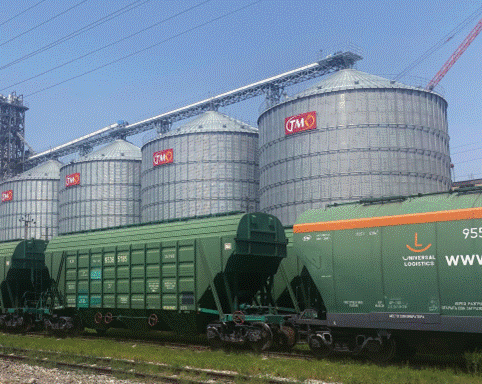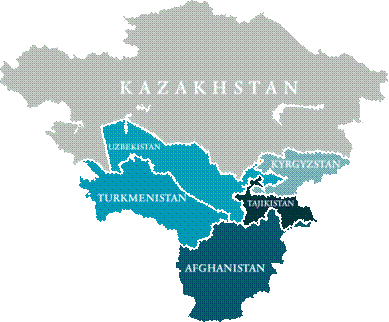The six landlocked countries of Central Asia form an integrated and largely self-sufficient wheat economy. Around 26 million tonnes of the food grain are produced and consumed by the combined population of 108 million.
While all countries grow wheat as a major crop, Kazakhstan is the only surplus producer. The other five are net importers with all to a varying degree dependent on spring wheat from the Kazakh steppes as their main food staple.
For many years Kazakhstan has ranked as one of the world’s leading wheat flour exporters with Uzbekistan, Afghanistan and Tajikistan the biggest markets in that order.
However, in the last decade the milling industries in these countries have evolved rapidly thanks to new investment stimulated by economic reforms. The main outcome has been less flour, but more wheat shipped from Kazakhstan to its neighbors, as domestic mills meet demand, especially among the urban population.

Kazakhstan mostly grows rainfed wheat on the vast farms of its northern region contiguous with Russia’s wheat belt spanning western Siberia and the south- ern Urals. Yields vary greatly depending on precipi- tation. Total wheat harvests have ranged from 11.5 million to 15 million tonnes in the last decade with a five-year average of 12.9 million tonnes.
The country’s 19 million population consumes just over one-third of the annual crop, leaving the rest available for export.
Formerly most wheat flour used by small tandoor bakeries in major urban centers such as Tashkent, Dushanbe, Bishkek as well as Afghanistan's major cit- ies was supplied from large-scale industrial millers in Kazakhstan.
Many of these mills now have been idled due to the local competition in their largest traditional flour ex- port markets.
Kazakhstan's government subsidizes diesel fuel and fertilizer for private grain growers and retains a cou- ple of other policy levers for intervention in the cru- cial wheat market. The state-owned Food Contracting Corp. functions as a strategic wheat reserve seasonally holding up to 500,000 tonnes, representing 10% of do- mestic consumption, and a permanent level of 250,000 tonnes.
The government also imposes export quotas every year from April 15 to July 15, which are lifted when it is determined that available wheat will meet domestic needs until the impending harvest in September.
The sharp rise in wheat prices related to the Ukraine war have resulted in the quotas being extended to Sept. 30 this year, though they were only 54% utilized for wheat due to high commodity prices.
In the last few years, Russia, China and Iran have become greater players on the supply and demand side for Kazakhstan wheat trading. Imports from Russia rose from a low level in 2018 sharply to 1.4 million tonnes in 2021 before dropping off sharply as a result of ex- port restrictions this year. During the September 2021 to February 2022 crop marketing season, Iran increased its imports from Kazakhstan fivefold compared to the previous year to 373,000 tonnes. This helped make up for a COVID-related near halt in wheat exports to China in the last year through a new rail grain terminal in Ali Shan — part of the Belt and Road Initiative — which had been averaging 350,000 tonnes annually since 2019.
With 31 million inhabitants, Uzbekistan is the most populous of the former Soviet republics of Central Asia. It is also the world’s only major country that is double-landlocked since no neighboring countries have an outlet to the ocean.
Naan is the staple food of nearly all Uzbeks.
A vast irrigation infrastructure fed by reservoirs in the Tianshan mountains allows the country to grow enough winter wheat for its own consumption. But the low glu- ten and high starch content typical of such wheat makes it less desirable for baking naan. Consequently, tandoor bakers in Tashkent and other large cities have been key demand drivers for the largest market for Kazakhstan flour and wheat, with imports of 3.4 million tonnes in the 2020-21 marketing year.
The state-owned milling holding company Uzdonmahsolut encompasses 43 milling plants that buy up around 4 million tonnes of the annual domestic harvest, which has averaged 6 million tonnes over the last five years. Since independence in 1990, central planning had been retained for wheat and cotton, the two main crops. But in recent years following the 2016 death of the au- tocratic leader of nearly three decades, President Islam Karimov, wheat and flour prices were liberalized, and investment in private milling capacity has accelerated. These private mills rely mainly on high quality wheat imported from Kazakhstan. In addition to re-placing Kazakhstan-milled flour in the domestic mar- ket, private Uzbek millers have taken market share from Kazakhstan millers exporting to Afghanistan.
Uzbekistan's five-year average annual wheat imports are 3.2 million tonnes, but exports, mainly in the form of wheat flour to Afghanistan, climbed to 1 million tonnes in 2021 per USDA data.
The government's wide-ranging privatization program is targeting the apparatus of Uzdonmahsulot. Planning is underway to auction off 20 of its milling plants in a first stage, though the process has undergone delays.
Tajikistan, with a population of 10 million, imports over 1 million tonnes of wheat from Kazakhstan per year. A decade ago, Kazakh flour exports to the country exceeded wheat. But in the last year the flour compo- nent has fallen to less than 90,000 tonnes.
An import duty of 18% on flour versus 10% on wheat provided a major stimulus for construction of new mills, particularly in northern Sugd Province. Nearly all wheat arrives in bulk railcars by the shortest route transiting Uzbekistan. The distance by rail to Dushanbe is another 1,500 kilometers to circumvent the country’s mountainous northwest.
As a result, 90% of the wheat imported to Tajikistan is milled in the north. Flour is transported by truck over two mountain passes to Dushanbe and the populous Hatlon region further south.
Flour milling in Tajikistan is highly competitive based on quality and price. Five years ago, there were still around 30 milling plants operating mainly around Khujand, the capital of Sogd Province and in Dushanbe.

Today just four milling companies account for 80% or so of flour output. Nearly all remaining mills with 50 to 100 tonnes daily capacity have shut down in the last few years.
Farovon Group operates the country’s largest milling plant at 600 tonnes per day of wheat. It was started up at a greenfield site in 2021. The company has a second older mill that meets extra demand bringing total daily capacity to 1,100 tonnes.
The second and third leading millers are Ordi Fatir and Zernovaya Kompaniya, both also in the northern region.
Afghanistan is the most populous (37 million) and by far the poorest country in Central Asia. It is the only nation among the six that was not part of the USSR. Annual wheat production and imports have averaged 4.5 mil- lion tonnes and 3.3 million tonnes, respectively, during the last five years.
The composition and origin ofthe country’s wheat im- ports have evolved markedly in recent decades. Twenty years ago, most flour consumed in urban areas came across the border from Pakistan with as many as 1,000 truckloads daily originating in Karachi and other mill- ing centers. Gradually higher quality Kazakhstan wheat flour suitable for naan supplanted Pakistani production, where exportable surpluses in any case were falling due to that country’s rapid population growth.
Despite the last two decades of war, much local, private sector investment in new milling capacity has taken place, with a few dozen mills of 50 to 150 tonnes daily capacity springing up. These enterprises have resulted in a major shift to wheat purchases from Kazakhstan in place of flour.
Wheat is efficiently transported in bulk rail cars via Uzbekistan and on a separate newer rail line that circum- vents Uzbekistan to the west but transits Turkmenistan.
Turkmenistan is the only country in the region whose wheat value chain from cropping to processing and dis- tribution remains mostly in government hands. State revenues from natural gas export have made possible subsidization of highly mechanized agriculture and large investments in modern storage, milling, baking and pasta technology.
The former collective farms of the Soviet era have been reorganized as peasant associations, but they still sell nearly all their grain to state milling enterprises at fixed prices.
Some economic reforms have resulted in a limited number of privately owned bakeries. The price of gov- ernment bread also has been doubled to two manat (USD 0.57) per loaf in recent years.
Turkmenistan’s dependence on irrigation results in a soft, white wheat. The state imports hard wheat from Kazakhstan for blending in order to produce a higher gluten flour suitable for naan and other bread types pre- ferred by urban consumers.
Official government data show a population of 5.6 million, and the USDA reports the five-year aver- age wheat crop and imports at 1.1 million tonnes and 320,000 tonnes, respectively, with only a small compo- nent of imported flour. However, an expert source with recent experience inside the country maintains that all three figures may be much lower due to outward mi- gration following a disastrous harvest in 2018. Another driver is lack of opportunity under the repressive cen- trally planned economy.
Together with Kazakhstan, Kyrgyzstan is part of the Eurasian Economic Union with Russia. Without any protective import duties to contend with, large Kazakhstan milling companies supply about 20% of wheat flour consumption in Kyrgyzstan. This is mainly in the capital city of Bishkek in the north close to the border between the two countries. Small private indus- trial and village millers process much of the 800,000 tonnes of wheat grown in the country for use in the Ferghana Valley to the south and in mountainous re-gions of the country of 6 million people.
by David McKee
Derechos de autor © Hebei Pingle Flour Machinery Group Co., Ltd. All Rights Reserved | Mapa del sitio | Technical Support: 